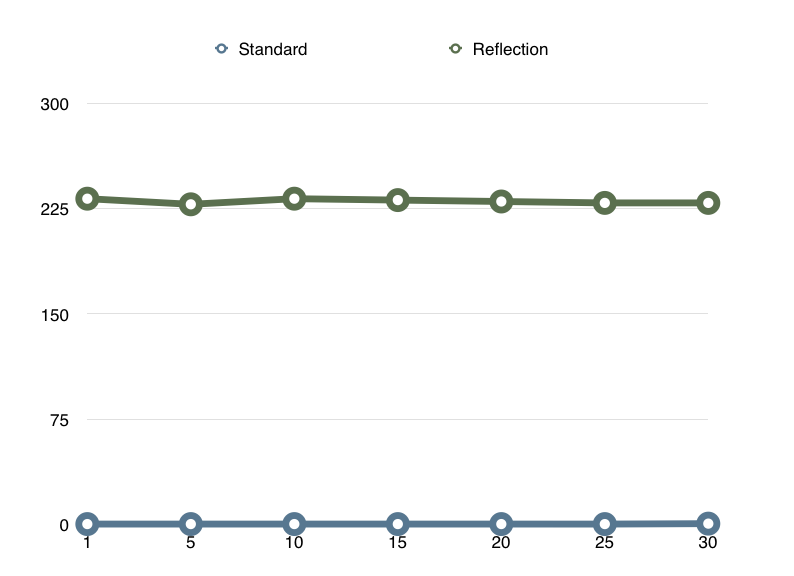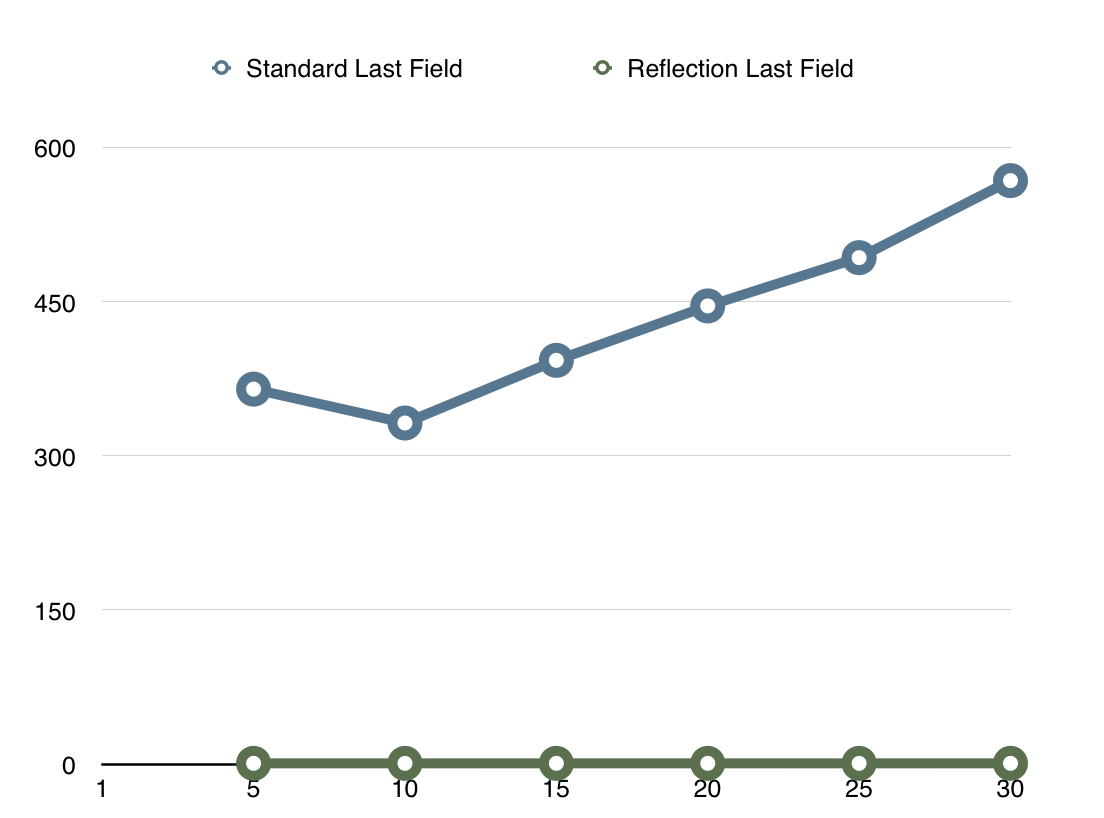How slow is reflection and how types of a function affect its performance.
Bellow are some benchmarks designed to explore the performance of reflection package and of arguments of different types in functions, for Go.
There are 7 kind of structs, among which the difference is their field number, starting from 1 field, then 5 fields, 10 fields, ..., up to 30 fields. There are four benchmarks, two of reflection and two of non-reflection.
A example of these benchmarks:
type FiveFields struct {
Field1 int
Field2 int
Field3 int
Field4 int
Field5 int
}
func BenchmarkReflectFiveFields(b *testing.B) {
foo := reflect.ValueOf(FiveFields{})
for i := 0; i < b.N; i++ {
_ = foo.FieldByName("Field1").String()
}
}
func BenchmarkStandbardFiveFields(b *testing.B) {
foo := FiveFields{}
for i := 0; i < b.N; i++ {
_ = foo.Field1
}
}
func BenchmarkReflectLastFiveFields(b *testing.B) {
foo := reflect.ValueOf(FiveFields{})
for i := 0; i < b.N; i++ {
_ = foo.FieldByName("Field5").String()
}
}
func BenchmarkStandbardLastFiveFields(b *testing.B) {
foo := FiveFields{}
for i := 0; i < b.N; i++ {
_ = foo.Field5
}
}
And running result is:
Access first field:
Access last field:
From the data, we could see that reflection is almost always slower than a typical access in 2 factors. What's more, with the increase in the number of fields, accessing fields that are written near the bottom of the field list, it's slower.
Similar to fields in structs while fields is replaces by methods, a benchmark example:
type TenFields struct {}
func (f TenFields) Field1() {}
func (f TenFields) Field2() {}
func (f TenFields) Field3() {}
func (f TenFields) Field4() {}
func (f TenFields) Field5() {}
func (f TenFields) Field6() {}
func (f TenFields) Field7() {}
func (f TenFields) Field8() {}
func (f TenFields) Field9() {}
func (f TenFields) Field10() {}
func BenchmarkReflectTenFields(b *testing.B) {
foo := reflect.ValueOf(TenFields{})
for i := 0; i < b.N; i++ {
foo.MethodByName("Field1").Call(nil)
}
}
func BenchmarkStandbardTenFields(b *testing.B) {
foo := TenFields{}
for i := 0; i < b.N; i++ {
foo.Field1()
}
}
func BenchmarkReflectLastTenFields(b *testing.B) {
foo := reflect.ValueOf(TenFields{})
for i := 0; i < b.N; i++ {
foo.MethodByName("Field10").Call(nil)
}
}
func BenchmarkStandbardLastTenFields(b *testing.B) {
foo := TenFields{}
for i := 0; i < b.N; i++ {
foo.Field10()
}
}
Access first method:
Access last method:
Accessing struct methods via reflection has similar benchmark results like accessing fields. It's slow and methods that get parsed later are more slower when being accessed by reflection.
Int Benchmark example:
func NoIntArg() {}
func OneIntArg(arg int) {}
func FiveIntArgs(arg1, arg2, arg3, arg4, arg5 int) {}
func TenIntArgs(arg1, arg2, arg3, arg4, arg5, arg6, arg7, arg8, arg9, arg10 int) {}
func FifteenIntArgs(arg1, arg2, arg3, arg4, arg5, arg6, arg7, arg8, arg9, arg10, arg11, arg12, arg13, arg14, arg15 int) {
}
func TwentyIntArgs(arg1, arg2, arg3, arg4, arg5, arg6, arg7, arg8, arg9, arg10, arg11, arg12, arg13, arg14, arg15, arg16, arg17, arg18, arg19, arg20 int) {
}
func BenchmarkNoIntArg(b *testing.B) {
for i := 0; i < b.N; i++ {
NoIntArg()
}
}
func BenchmarkOneIntArg(b *testing.B) {
for i := 0; i < b.N; i++ {
OneIntArg(0)
}
}
func BenchmarkFiveIntArgs(b *testing.B) {
for i := 0; i < b.N; i++ {
FiveIntArgs(0, 0, 0, 0, 0)
}
}
func BenchmarkTenIntArgs(b *testing.B) {
for i := 0; i < b.N; i++ {
TenIntArgs(0, 0, 0, 0, 0, 0, 0, 0, 0, 0)
}
}
func BenchmarkFifteenIntArgs(b *testing.B) {
for i := 0; i < b.N; i++ {
FifteenIntArgs(0, 0, 0, 0, 0, 0, 0, 0, 0, 0, 0, 0, 0, 0, 0)
}
}
func BenchmarkTwentyIntArgs(b *testing.B) {
for i := 0; i < b.N; i++ {
TwentyIntArgs(0, 0, 0, 0, 0, 0, 0, 0, 0, 0, 0, 0, 0, 0, 0, 0, 0, 0, 0, 0)
}
}
The most interesting fact of these benchmarks is that for most types, the number of function arguments do not slower down a function significantly. The exceptions are map and big structs.
Actually, we could find out that map is actually a very expensive data structure, at least for calling functions / methods.
Reflection is indeed slow.
Simple is better. When we design data structure, we should always prefer simple solutions. If int could
The result of this exploration is actually not surprising at all. We do know reflection is slow and map is costly.
These not-yet-complete benchmarks could also serve as a simple guide line when designing programs.
This post has no intension to discourage any usage of so-called costly things. But I think as a programmer, when we are designing something, we should understand what we are actually doing. Using inappropriate data structure or over complicated design is wrong indeed.
For example, when we need to pass data to template (the standard library text/template). It's very convenient that we could just use a map as a container like this:
data := map[string]interface{}{
"Post": post,
"Author": author,
"Age", age,
}
But actually, using a anonymous struct is way better:
data := struct {
Post PostType
Author AuthorType
Age int
}{post, author, age}
No only it's cheap, but also it's more clear and useful. And when you are using the data incorrectly in your template, it will fail loudly to attract your attention and help you locate and debug the problem efficiently. For example, text/template will panic when you do {{.NonexistField}} when the data is a struct but do nothing when it's a map.
Suggestions and corrections are always welcome. Thanks for your reading.









